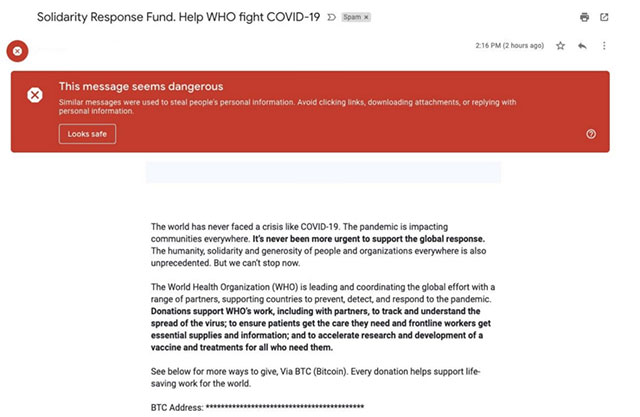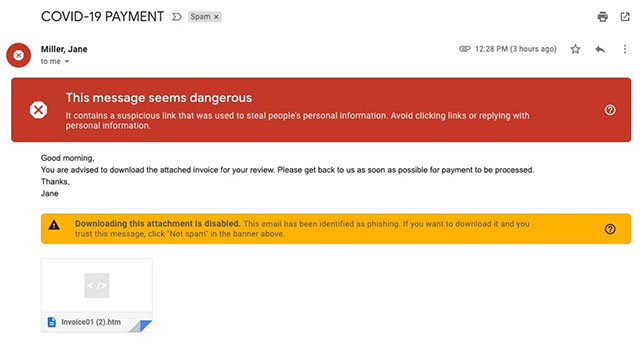Warning: The number of malicious emails is increasing rapidly on Gmail and recommendations from Google
Recently, Quantrimang has had many articles warning readers about the situation of hackers actively taking advantage of the complicated situation of COVID-19 epidemic to deploy online fraud activities as well as spreading malicious code on. Globally. After a series of fraudulent actions, cyberattacks were exposed as well as prevented, hackers still seem to have not given up.
Recently, Google said it has successfully prevented millions of malicious COVID-19-related emails on Gmail every day, continuously for more than a week, and issued warnings and recommendations for self-protection. yourself against the escalating network attack situation.
Specifically, the company's security team intervened and successfully blocked 18 million phishing emails, containing malicious code related to the Corona virus every day last week, accounting for nearly 20% of the total number of fraudulent emails blocked. day. That's not to mention the 240 million spam emails about Covid-19 that the system automatically filters by day. Google confirmed its machine learning algorithm for 99.9% spam filtering ability, and noted that the common spam emails are mainly fake emails of agencies and organizations belonging to WHO / Governments, with the content of requesting anti-epidemic donations or providing personal information.
'We have applied proactive monitoring for malware related to COVID-19 and phishing emails on general security systems and processes. In many cases, these threats are not new, they have been documented malware distribution campaigns, but are shrouded in the form of disease-related applications, exploiting attention. Everyone's altitude for COVID-19.
Once a threat is identified, we list it in the Safe Browsing API, protecting users in Chrome, Gmail and all other integrated products. Safe Browsing now helps protect more than 4 billion devices a day by showing warnings to users when they try to navigate dangerous websites or download malicious attachments. '
 Phishing email Deceptive
Phishing email Deceptive  email download malicious code
email download malicious code Besides, Google also recommends things that users should and should not do to keep themselves safe in the current situation:
- Complete the Security Checkup security process to improve account security.
- Avoid downloading files of unknown origin. Instead, use the integrated document preview feature in Gmail.
- Check the integrity of the URL before providing login information or clicking on the link in the email. Fake URLs often mimic real URLs and include additional words or domains.
- Report suspected emails.
- Consider signing up for Google's Advanced Protection Program (APP) service for better protection.
You should read it
- Steps to protect email against malicious threats
- What is email encryption? Why does it play an important role in email security?
- Why is Gmail filtering good spam?
- The only secure email is the text-only email
- ROPEMAKER allows an attacker to change email after sending
- Instructions to delete spam automatically in Gmail
- Warning: New email phishing tactics appear
- Google launched a new feature that makes Gmail even more useful and interactive
May be interested
- How to forward multiple Gmail emails at once
 to forward multiple gmail emails at the same time to another account, we will immediately use the options available on gmail without the need for external utilities or applications.
to forward multiple gmail emails at the same time to another account, we will immediately use the options available on gmail without the need for external utilities or applications. - Google has just patched a critical Gmail vulnerability, allowing hackers to send fake emails
 google just patched a critical vulnerability affecting gmail and g suite. this vulnerability allows hackers to send fake identity emails to scam users.
google just patched a critical vulnerability affecting gmail and g suite. this vulnerability allows hackers to send fake identity emails to scam users. - Warning: The number of vulnerabilities in open source software are increasing rapidly
 besides malware, spam emails or ddos attacks, vulnerabilities in open source software are also considered as one of the most significant security threats at the moment.
besides malware, spam emails or ddos attacks, vulnerabilities in open source software are also considered as one of the most significant security threats at the moment. - Already able to download Gmail data, Google Calendar
 google has just released a long-awaited user feature: download a copy of gmail data and google calendar. new feature allows you to backup emails and calendars or export them temporarily to import other services.
google has just released a long-awaited user feature: download a copy of gmail data and google calendar. new feature allows you to backup emails and calendars or export them temporarily to import other services. - Swipe tips to quickly delete emails in Gmail iPhone
 the gmail app on iphone does not have a swipe to delete option, you need to press and hold and select delete to do so. here is a guide on how to swipe to delete emails in gmail iphone.
the gmail app on iphone does not have a swipe to delete option, you need to press and hold and select delete to do so. here is a guide on how to swipe to delete emails in gmail iphone. - Warning: New malicious code is infecting about 500,000 router devices
 cisco researchers have released a warning warning about a malicious malicious code called vpnfilter, which is spread by a group of hackers spreading more than 500,000 home or small companies' devices across the globe. world.
cisco researchers have released a warning warning about a malicious malicious code called vpnfilter, which is spread by a group of hackers spreading more than 500,000 home or small companies' devices across the globe. world. - Google will stop reading emails in the user's Gmail to determine the ad audience
 if you are interested in security in gmail, this is good news. google will stop peeking email in the user's inbox.
if you are interested in security in gmail, this is good news. google will stop peeking email in the user's inbox. - Fix the authentication message error when signing up for Gmail
 when registering a new account or logging into a gmail account using two-layer security, google typically sends a verification message via the phone number that the user has registered. however, the last time some users received a confirmation code, google replaced the number of digits, making login / registration difficult.
when registering a new account or logging into a gmail account using two-layer security, google typically sends a verification message via the phone number that the user has registered. however, the last time some users received a confirmation code, google replaced the number of digits, making login / registration difficult. - Discover useful Gmail features
 perhaps you have mastered the basic features of the gmail service such as setting up contacts, sending email ... however, gmail has many other useful uses that you may not know ...
perhaps you have mastered the basic features of the gmail service such as setting up contacts, sending email ... however, gmail has many other useful uses that you may not know ... - How to delete all emails at once in Gmail
 want to clean up your gmail inbox? through gmail's bulk delete option, you can easily delete all emails from your gmail account at once with just a few clicks.
want to clean up your gmail inbox? through gmail's bulk delete option, you can easily delete all emails from your gmail account at once with just a few clicks.










 Warning: Cybercriminals are targeting Zoom, Google Classroom and Teams
Warning: Cybercriminals are targeting Zoom, Google Classroom and Teams Intel released the 10th generation H series CPUs for laptops, promising outstanding performance
Intel released the 10th generation H series CPUs for laptops, promising outstanding performance The world's largest hacker forum has just been hacked, many members like 'sitting on a fire'
The world's largest hacker forum has just been hacked, many members like 'sitting on a fire' Will 5G make us more vulnerable to cyber attacks?
Will 5G make us more vulnerable to cyber attacks? Zoom iOS application was detected sending data to Facebook
Zoom iOS application was detected sending data to Facebook Apple has released an update to patch a series of vulnerabilities in iOS, macOS, Safari and many other platforms, update now!
Apple has released an update to patch a series of vulnerabilities in iOS, macOS, Safari and many other platforms, update now!